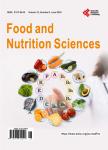Microencapsulation of Banana Passion Fruit (<i>Passiflora tripartita Var. Mollissima</i>): A New Alternative as a Natural Additive as Antioxidant
Microencapsulation of Banana Passion Fruit (<i>Passiflora tripartita Var. Mollissima</i>): A New Alternative as a Natural Additive as Antioxidant作者机构:Chemestry Ecole National University of Colombia Medellin Colombia Engineering Faculty Lasalian University Corporation Caldas Colombia
出 版 物:《Food and Nutrition Sciences》 (食品与营养科学(英文))
年 卷 期:2014年第5卷第8期
页 面:671-682页
学科分类:1002[医学-临床医学] 100214[医学-肿瘤学] 10[医学]
主 题:Passiflora tripartite ABTS Maltodextrin Microencapsulation Phenolic Compound
摘 要:Banana passion fruit (P. tripartita var. Mollissima) is one of the most promising tropical fruits giving its antioxidant activity (AOA) to replace synthetic additives. Despite this property, there are no studies about the metabolites responsible for its biological function or proposals for the application of technologies, such as microencapsulation by spray drying, to improve its properties and ease its incorporation in several food matrices. The aim of this study is to microencapsulate the pulp of banana passion fruit with several mixtures of encapsulants and identify which one of these mixtures is better to preserve its AOA. The antioxidant activity values for the banana passion fruit pulp were as follows: DPPH: 6630.2 ± 91 μMtrolox/100g;ABTS: 18764.3 ± 270.4 μMtrolox/100g;FRAP: 1703.6± 938.2 mgAA/100g, ORAC: 8105.4 ± 424.2 μmol TEAC/100g of sample;Total phenols: 8862.2 ± 451.4 gallic ac. mg/100g. The concentrations of the bioactive compounds expressed in mg of gallic acid per 100 g of the pulp on a dry base were 13.9 ± 0.004;5.9 ± 0.001 and 126.3 ± 0.004 for caffeic, p-coumaric and ferulic acids, respectively. The best shelf-life followed by ABTS in eight assays was between 28.8 and 31.5 weeks using maltodextrin and modified starch, MD:MS (1/4:3/4) and MD:MS (0:1), respectively. In conclusion, ABTS is the best method to measure the AOA in banana passion fruit because it correlated with the phenolic compounds better than DPPH and FRAP methods. Additionally, two options were found to protect the AOA and to extent the shelf-life of the passion fruit by spray-drying, with mixtures of encapsulants widely used in the food industry.



